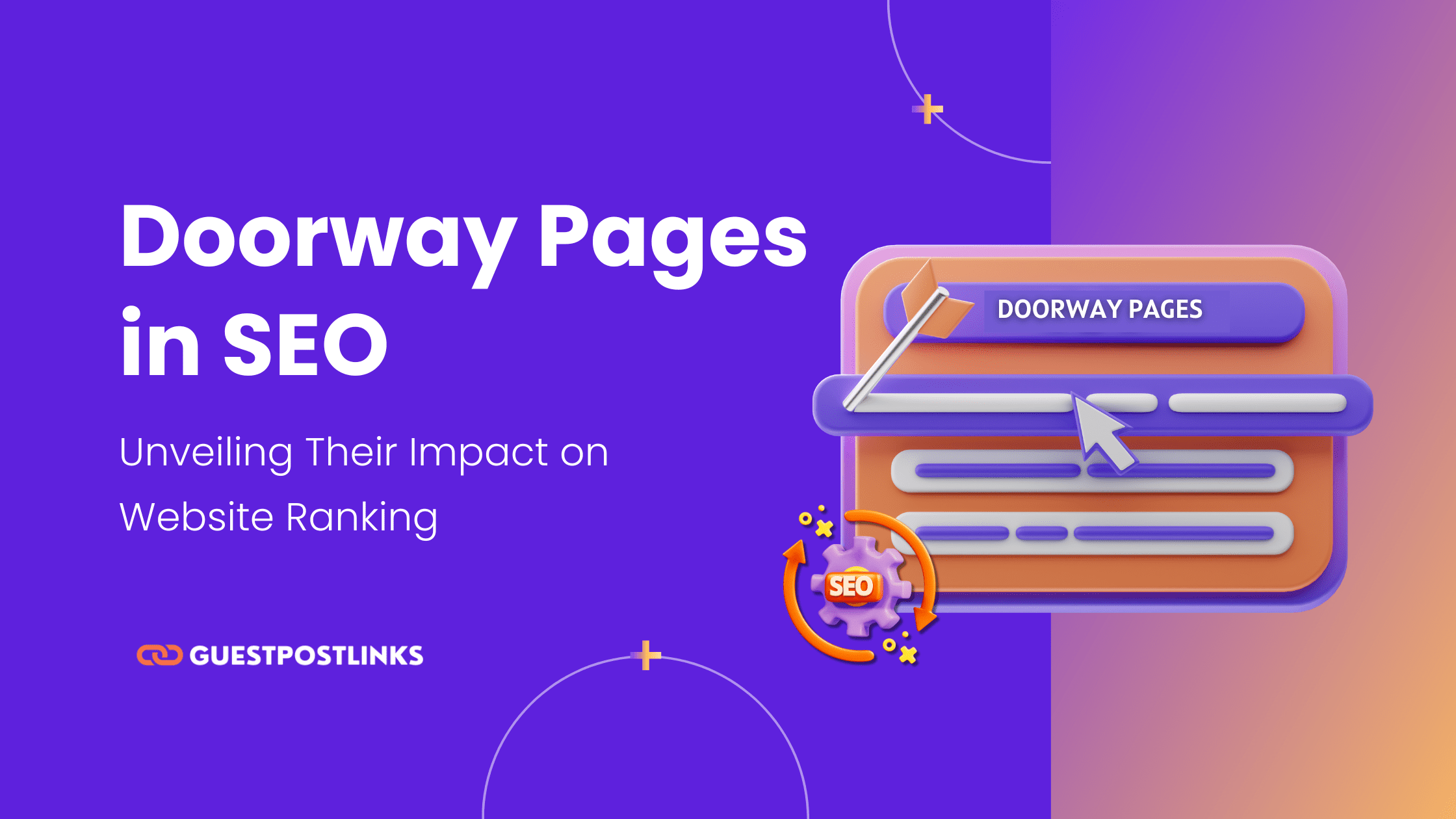Doorway pages may seem like a clever SEO shortcut, but in reality, they’re one of the fastest ways to attract a Google penalty.
The problem is simple: many businesses unknowingly create doorway pages while trying to rank for multiple keywords or locations. These low-value pages don’t serve users, clutter up websites, and often funnel visitors to the same destination frustrating both searchers and Google’s algorithms.
The result? Instead of higher rankings, sites using doorway pages risk being flagged as spam, losing visibility, and damaging brand trust.
The good news is that doorway pages can be avoided and if they already exist on your site, they can be fixed. In this guide, we’ll break down:
- What doorway pages are (with examples)
- Why Google penalizes them
- How to identify doorway pages on your site
- Proven alternatives that boost SEO without risking penalties
By the end, you’ll know how to protect your site, improve user experience, and build long-term SEO growth without falling into the “doorway page” trap.
What Are Doorway Pages?
Doorway pages are low-value web pages created solely to manipulate search rankings by targeting multiple variations of a keyword or location, then funneling users to the same destination. They provide little unique content, hurt user experience, and are considered a form of SEO spam.
Common Examples of Doorway Pages
- Location-based doorway pages – e.g., dozens of duplicate pages for “plumber in New York,” “plumber in Chicago,” etc., all leading to the same service page.
- Keyword-stuffed duplicates – thin pages optimized for different keyword phrases but offering no unique value.
- Gateway redirects – pages designed to capture clicks, then automatically redirecting users elsewhere.
What Google Says
According to Google’s Webmaster Guidelines:
Doorways are sites or pages created to rank for specific, similar search queries. They can lead to multiple similar pages in user search results, where each result ends up taking the user to essentially the same destination.” – Google Search Central
Why Google Penalizes Doorway Pages
Google’s Stance on Doorway Pages
Google has been fighting doorway pages for years because they degrade search quality. Instead of giving users the best answer, doorway pages clog search results with multiple thin pages that all lead to the same destination. This wastes user time and creates a frustrating experience.
The 2015 Doorway Page Algorithm Update
In March 2015, Google rolled out a major update specifically targeting doorway pages. The update aimed to filter out low-value pages that were designed to manipulate search visibility. Sites that relied heavily on duplicate city/service pages or keyword-spam content saw significant ranking drops.
Key takeaway: Google views doorway pages as an attempt to game the system, not help users.
Real-World Case: BMW Germany Penalty
A famous example occurred in 2006, when BMW Germany’s website was penalized and temporarily removed from Google for using doorway-style pages. These pages were stuffed with keywords and redirected visitors to different content than what was promised. This case highlighted Google’s strict stance: even large, trusted brands aren’t immune from penalties when doorway tactics are used.
Why Doorway Pages Hurt SEO
- They dilute content quality across multiple weak pages.
- They create redundant search results, harming UX.
- They damage trust by misleading users.
- They can trigger manual or algorithmic penalties, leading to traffic loss.
How to Identify Doorway Pages on Your Site
Why Identification Matters
Many site owners create doorway pages without realizing it. A page that seems optimized for SEO may actually be classified as a thin, manipulative page by Google. Identifying them early helps you avoid penalties and recover lost rankings.
Signs You’re Using Doorway Pages
Look out for these red flags:
- Duplicate City or Location Pages: Example: “Plumber in Dallas,” “Plumber in Houston,” “Plumber in Austin” all with nearly identical content leading to one main service page.
- Multiple Pages Targeting Slight Keyword Variations: e.g., “cheap flights,” “low-cost flights,” “budget flights” thin pages built only to capture variations.
- Thin SEO Landing Pages with No Unique Value: Pages that exist just to rank, with little or no helpful information for users.
- Pages That Funnel to the Same Destination: Several entry pages redirecting or linking to the same primary page.
- Hidden or Misleading Redirects: A doorway page promises one thing but takes users elsewhere.
Tools to Detect Doorway Pages
You can spot doorway pages with a mix of manual checks and SEO tools:
- Google Search Console – Look for duplicate titles, meta descriptions, and indexation anomalies.
- Ahrefs / SEMrush / Screaming Frog – Identify thin content, duplicate pages, and keyword cannibalization.
- Manual Search – Google site:yourdomain.com + keyword to see if multiple near-identical pages appear in search results.
Quick Diagnostic Checklist
Use this 5-step audit to find doorway pages:
- Run a content audit → flag pages under 300 words or with duplicate content.
- Check internal linking → doorway pages often point to the same page.
- Look for multiple similar URLs targeting different cities or phrases.
- Review redirect behavior → doorway pages often redirect users unexpectedly.
- Compare page intent vs. user value → if it only serves search engines, it’s likely a doorway.
Doorway Pages vs. Landing Pages
Why This Comparison Matters
One of the biggest SEO mistakes is confusing doorway pages with legitimate landing pages. While both are designed to capture search traffic, only one adds real value for users.
Key Differences at a Glance
| Factor | Doorway Pages | Landing Pages |
| Purpose | Created to manipulate search rankings by targeting multiple keyword variations | Built to serve a specific audience or campaign goal (e.g., lead generation, sales) |
| Content Quality | Thin, repetitive, often duplicated across pages | Unique, relevant, in-depth, tailored to user intent |
| User Experience | Misleading; often funnels to the same destination | Helpful, matches the promise of the ad or search result |
| Google’s View | Classified as spam, subject to penalties | Accepted and encouraged if user-focused |
| Example | “Cheap Flights in [City]” pages that all redirect to one booking page | A PPC campaign landing page with unique offers and form submissions |
The SEO Takeaway
- Doorway Pages = Short-term manipulation, long-term penalties.
- Landing Pages = Legitimate marketing assets that boost conversions.
If your page is designed to add real value (with unique content, clear CTAs, and useful info), it’s a landing page. If it exists only to trick Google with duplicate content, it’s a doorway page.
Real-World Examples & Consequences
Why Examples Matter
Doorway pages aren’t just a small website problem they’ve caught major global brands and countless local businesses off guard. Google has consistently taken strong action against doorway tactics to protect the quality of its search results.
Case Study 1: BMW Germany (2006)
In 2006, BMW’s German website was temporarily removed from Google’s index after being caught using doorway-style pages stuffed with keywords. These pages redirected users to different content than promised, violating Google’s Webmaster Guidelines.
- Impact: Massive traffic loss and global media attention.
- Lesson: Even household-name brands aren’t immune to Google penalties.
Case Study 2: Ricoh Germany (2006)
Alongside BMW, Ricoh Germany was also penalized for doorway-style redirects. The site used hidden pages designed to manipulate rankings, which Google classified as spam.
- Impact: Reputation damage and ranking loss.
- Lesson: Black-hat SEO tactics can destroy credibility.
Modern Example: Local Business SEO
Many small businesses still unknowingly create city-based doorway pages (e.g., “Dentist in Chicago,” “Dentist in Houston,” “Dentist in Dallas”) with near-duplicate content.
- Impact: Local rankings collapse when Google identifies these patterns.
- Lesson: Quality, unique local pages outperform doorway spam.
Consequences of Using Doorway Pages
Using doorway pages can lead to:
- Manual Penalties → Google can remove pages or entire sites from search.
- Algorithmic Demotion → Pages silently lose rankings due to quality updates.
- User Distrust → Visitors bounce quickly when they land on misleading pages.
- Revenue Loss → Less traffic, fewer leads, weaker brand reputation.
SEO-Friendly Alternatives to Doorway Pages
Why You Need Alternatives
Since doorway pages are considered spam, site owners need legitimate SEO strategies that attract organic traffic while complying with Google’s rules. The good news: there are proven methods to rank higher without risking penalties.
1. Create Unique Local Landing Pages
Instead of duplicating the same content across multiple city/service pages, build customized local landing pages with:
- City-specific testimonials or case studies
- Local images, maps, and events
- Unique FAQs for that location

2. Consolidate Thin Pages into Pillar Content
If you have multiple short, low-value pages, merge them into one comprehensive guide.
- Example: Instead of 10 doorway pages for “cheap flights in [city],” build a single, well-researched travel guide.
- Add sections, FAQs, and structured navigation.

3. Strengthen Internal Linking
Doorway pages often exist in isolation. Instead, use a logical internal linking strategy:
- Link related pages together contextually
- Use descriptive anchor text (“SEO penalties guide”) instead of “click here”
- Build topical silos (clusters of related pages pointing to a pillar page)

4. Use Structured Navigation & Site Architecture
- Group content by topic or service area
- Use breadcrumbs and clear category structures
- Avoid creating multiple duplicate paths to the same content

5. Focus on User-First SEO Content
Doorway pages exist to please search engines. Flip the script:
- Write for humans first, search engines second
- Add data, expert quotes, and visuals
- Ensure every page answers a clear user intent

6. Leverage Local SEO Best Practices
For businesses targeting multiple areas:
- Optimize Google Business Profiles for each location
- Use service area pages instead of duplicate city pages
- Collect local reviews and display them on the site

SEO Takeaway


By creating unique, user-focused content and strengthening your site’s structure and authority, you replace risky doorway tactics with strategies Google rewards.
How to Remove & Recover from Doorway Pages
Why Removal is Essential
If Google identifies doorway pages on your site, you risk manual actions, algorithmic demotion, and ranking loss. The good news is that doorway pages can be cleaned up with a structured recovery process.
Step-by-Step Guide to Removing Doorway Pages
Step 1: Audit Your Website
Use Google Search Console, Screaming Frog, or Ahrefs to find:
- Duplicate pages
- Thin content (under 300 words)
- Multiple pages targeting the same keyword
Step 2: Consolidate or Remove Duplicate Pages
- Merge doorway pages into a single high-value page (pillar content).
- Delete irrelevant doorway pages that add no user value.
Step 3: Apply 301 Redirects
- Redirect old doorway URLs to the most relevant new page.
- Avoid redirecting everything to the homepage (Google considers this spammy).
Step 4: Update Your Sitemap
- Remove deleted doorway URLs.
- Submit updated sitemap in Google Search Console.
Step 5: Monitor Performance
- Track rankings, impressions, and crawl errors in Google Search Console.
- Expect a 2–3 month recovery timeline, though some improvements can appear faster.
Tools That Can Help
- Google Search Console → Spot indexation anomalies.
- Screaming Frog / Sitebulb → Detect duplicate content & thin pages.
- SEMRush / Ahrefs → Identify keyword cannibalization issues.
Pro Tips for Recovery
- Add unique, valuable content to remaining pages.
- Strengthen internal linking to pillar content.
- Request a reconsideration request in Search Console if you’ve received a manual penalty.
- Document changes in case Google reviewers need evidence.
Recovery Timeline
- Quick Wins (2–6 weeks): Traffic may stabilize once doorway pages are removed.
- Medium-Term (2–3 months): Rankings improve as Google re-crawls and re-indexes your site.
- Long-Term (6+ months): Stronger domain authority if you maintain user-first SEO practices.
Final Word
Doorway pages may seem like a quick SEO trick, but they’re a long-term liability. The safest, most effective way to grow your search visibility is to follow Google’s guidelines, build trustworthy content, and invest in strategies that put users first.
Next Step: If you’re unsure whether your site contains doorway pages, consider running a full SEO audit or working with a trusted SEO professional to ensure your site stays penalty-free and future-proof.
Frequently Asked Questions (FAQ)
Doorway pages are thin, duplicate pages created to manipulate search rankings, often funneling users to the same destination. Landing pages, on the other hand, are legitimate marketing assets designed to deliver unique value, such as lead generation, product offers, or campaign-specific conversions.
Yes. Google officially classifies doorway pages as spam because they prioritize search engines over users. They fall under black-hat SEO tactics and can lead to ranking drops, manual penalties, or site deindexing.
You may have doorway pages if:
Multiple pages target the same keyword variation
Pages have thin or duplicate content
Several URLs redirect users to the same destination
Location-based pages look identical, except for the city name
Recovery depends on the severity of the issue:
Minor fixes (few pages): 2–6 weeks
Medium sites (dozens of pages): 2–3 months
Large sites with penalties: 3–6+ months
Google must re-crawl, re-index, and re-evaluate your site before rankings improve.
Some doorway pages may temporarily rank, but Google’s core updates and spam policies continually target them. Even if they provide short-term traffic, they almost always result in long-term penalties. Sustainable SEO requires unique, user-focused content, not manipulative pages.





 No publishers in the cart.
No publishers in the cart.